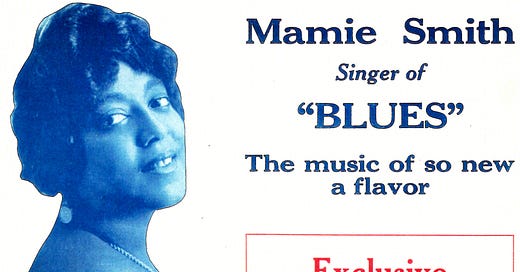The First Blues Recordings
How Mamie Smith’s “Crazy Blues” Launched the Blues Recording Industry
In 1920, Mamie Smith’s “Crazy Blues,” the first recording of a Black person singing the blues, revolutionized popular music. Witnesses claimed that after the record’s release, “Crazy Blues” could be heard through the open windows of virtually any black neighborhood in America. “That record turned around the recording industry,” remembered New Orleans jazzman Danny Barker. “Every family had a phonograph in their house, specifically behind Mamie Smith’s first record.”
A veteran of vaudeville and the chorus line, Mamie Smith was born on May 26, 1890. Raised in Cincinnati, she left home to go on the road with the Four Dancing Mitchells. She then joined the chorus of the Smart Set Company, which landed her in Harlem, where she settled. Perry Bradford spotted her singing at a cabaret and in 1918 gave her a spot in the musical Made in Harlem at the Lincoln Theater. Smith’s big number was his song “Harlem Blues.”
Bradford, who spent his afternoons working out new songs on the piano at Harlem’s Colored Vaudeville Benevolent Association, had long dreamed of having Black Americans record blues songs. In his 1965 autobiography, Born with the Blues, Bradford remembered that most of New York’s Black musicians didn’t care for blues, which seemed to symbolize everything they tried to leave behind in the South. “Whenever I began drifting into the lowdown, melancholy strains of the levee-camp ‘jive,’” Bradford wrote, “someone would yell to detract my attention: ‘You’re wanted on the phone,’ or, ‘Come on and have a glass of suds’—anything to keep me from whipping out those distasteful blues.”
Bradford, who’d lived in Mississippi and Georgia, was certain blues records could be alchemized into gold by creating a market in the South. For months he had been making the rounds of record companies, trying to sell them on his songs and his protégé, Mamie Smith. His persistence had earned him the nickname “Mule.”
His first nibble came from Victor Records. On January 10, 1920, Mamie Smith was ushered into a studio to cut a bare-bones trial recording of Bradford’s song “That Thing Called Love” set to her own piano accompaniment. Victor rejected it. The break Bradford had been searching for came soon afterward, when Otto Heinemann, president of fledgling OKeh Records, told Bradford of his interest in recording the blues. Bradford then met with Fred Hager, the company’s recording manager, telling him, “There are fourteen million Negroes in our great country, and they will buy records if recorded by one of their own, because we are the only folks that can sing and interpret hot jazz songs just off the griddle correctly.” Asked what songs he had in mind, Bradford handed Hager sheet music for two non-blues songs he’d composed, “That Thing Called Love” and “You Can’t Keep a Good Man Down.”
Impressed, Hager initially wanted Sophie Tucker, a white singer, to record the songs, but she was contracted to another label. Bradford convinced him to give a Black singer the chance. Mamie, he promised, would “do more with those songs than a monkey can do with a peanut; she sings jazz songs with more soulful feeling than any other girls, for it’s only natural for us.”
Keep reading with a 7-day free trial
Subscribe to Talking Guitar ★ Jas Obrecht's Music Magazine to keep reading this post and get 7 days of free access to the full post archives.



